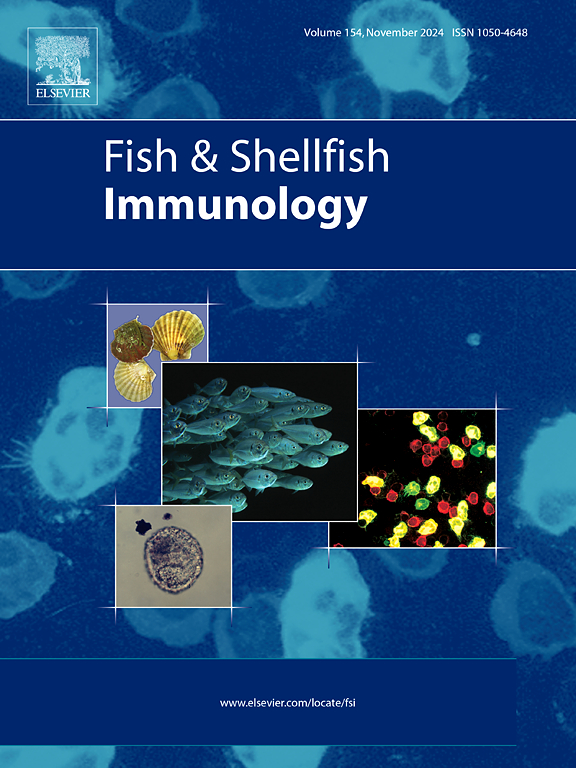Functional characterization of two CCL20 chemokines in black rockfish (Sebastes schlegelii): dual roles in immune cell recruitment and direct antimicrobial defense
IF 3.9
2区 农林科学
Q1 FISHERIES
引用次数: 0
Abstract
Chemokines are cytokines with chemotactic capacities that regulate immune cell migration under both inflammatory and homeostatic conditions. To date, reports about the role of CCL20 in the fish immune system have been limited. In this study, we identified two CCL20 homologs (CCL20a.1/2) from black rockfish (Sebastes schlegelii), investigating their expression profiles post-Aeromonas salmonicida infection, chemotactic properties, antimicrobial mechanisms, and immunoregulatory functions. Structural characterization revealed SsCCL20a.1 possesses a 369-bp ORF encoding 122 amino acids, whereas SsCCL20a.2 contains a 309-bp ORF encoding 102 amino acids. Phylogenetic analysis demonstrated the closest homology to honeycomb rockfish CCL20, supported by conserved syntenic patterns across vertebrates. Tissue distribution analysis showed constitutive expression of both genes across all nine tissues, with peak expression in gill (SsCCL20a.1) and liver (SsCCL20a.2), and minimal levels in brain and spleen, respectively. Following bacterial challenge, both genes displayed significant upregulation in liver, kidney, and gill at multiple timepoints. In vitro functional assays revealed potent chemotactic activity toward spleen leukocytes and peripheral blood leukocytes. Notably, SsCCL20a.1/2 exhibited strong binding capacity to microbial ligands (LPS, PGN, LTA) and Poly (I:C), and broad-spectrum bacterial agglutination. Mechanistic studies indicated direct bactericidal effects mediated through membrane disruption, as evidenced by structural damage to pathogen membranes. This investigation highlights the dual functionality of teleost CCL20 in orchestrating immune cell recruitment and executing direct antimicrobial defense, providing novel insights for developing therapeutic strategies against aquaculture pathogens.
两种CCL20趋化因子在黑岩鱼(sebases schlegelii)中的功能表征:在免疫细胞募集和直接抗菌防御中的双重作用。
趋化因子是具有趋化能力的细胞因子,在炎症和稳态条件下调节免疫细胞迁移。迄今为止,关于CCL20在鱼类免疫系统中的作用的报道还很有限。在这项研究中,我们从黑岩鱼(sebases schlegelii)中鉴定了两个CCL20同源物(CCL20a.1/2),研究了它们在沙门氏菌气单胞菌感染后的表达谱、趋化特性、抗菌机制和免疫调节功能。结构表征显示SsCCL20a。1的ORF全长369 bp,编码122个氨基酸,而SsCCL20a的ORF全长369 bp。2包含一个309 bp的ORF,编码102个氨基酸。系统发育分析表明其与蜂窝岩鱼CCL20具有最密切的同源性,在脊椎动物中具有保守的共生性模式。组织分布分析显示,这两个基因在所有9个组织中均有组成性表达,在鳃(SsCCL20a.1)和肝脏(SsCCL20a)中表达峰值。2),脑和脾中含量最低。在细菌攻击后,这两个基因在多个时间点上在肝脏、肾脏和鳃中都表现出显著的上调。体外功能分析显示其对脾白细胞和外周血白细胞具有明显的趋化活性。值得注意的是,SsCCL20a。1/2对微生物配体(LPS, PGN, LTA)和Poly (I:C)具有较强的结合能力,并具有广谱的细菌凝集能力。机制研究表明,直接的杀菌作用是通过膜破坏介导的,正如病原体膜的结构损伤所证明的那样。该研究强调了硬骨鱼CCL20在协调免疫细胞募集和执行直接抗菌防御方面的双重功能,为开发针对水产养殖病原体的治疗策略提供了新的见解。
本文章由计算机程序翻译,如有差异,请以英文原文为准。
求助全文
约1分钟内获得全文
求助全文
来源期刊

Fish & shellfish immunology
农林科学-海洋与淡水生物学
CiteScore
7.50
自引率
19.10%
发文量
750
审稿时长
68 days
期刊介绍:
Fish and Shellfish Immunology rapidly publishes high-quality, peer-refereed contributions in the expanding fields of fish and shellfish immunology. It presents studies on the basic mechanisms of both the specific and non-specific defense systems, the cells, tissues, and humoral factors involved, their dependence on environmental and intrinsic factors, response to pathogens, response to vaccination, and applied studies on the development of specific vaccines for use in the aquaculture industry.
 求助内容:
求助内容: 应助结果提醒方式:
应助结果提醒方式:


